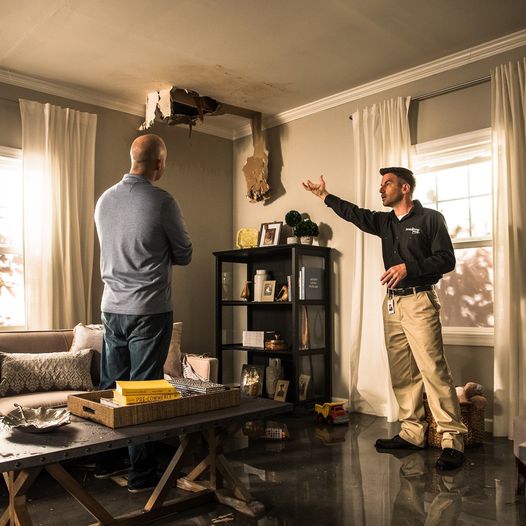In Water Damage Restoration time is of the essence. Before choosing a company, ask about their years of experience, if their employees have water mitigation certification, and if they offer emergency services available 24 hours a day.
The first step is property stabilization. This includes the use of tarps and other prevention techniques to avoid further damage or mold growth.
As soon as the water is gone, it’s important to clean and sanitize the affected area. This is done to prevent the spread of bacteria and other contaminants. It also helps reduce the chances of mold and mildew growing in the future.
The first step of this process involves checking the extent of the damage. This is done by analyzing the amount of moisture in the affected areas and looking at the extent of the damage. Then, a remediation specialist determines if the area is safe to begin cleaning.
This step is essential because it ensures that the entire home is free of mold and mildew before moving on to other restoration work. During this stage, experts use foam, abrasive, or immersion cleaning techniques to thoroughly clean all materials in the home. They also dispose of any contaminated materials as needed. This includes things like drywall and carpet, which may need to be replaced.
Depending on the type of water that caused the damage, this step can take several days to a week. However, it’s best to complete this step as quickly as possible to minimize the long-term effects of water infiltration.
When choosing a company to do your water damage restoration, make sure they are IICRC-certified. This means they’re experienced and follow the latest industry standards. It’s also a good idea to ask the company for references from previous clients. This will help you find out more about the quality of their services and their response time.
Before the restoration process begins, it’s important to ensure that all family members and pets are out of the house. Then, if necessary, the water restoration specialist will shut off any gas lines and electrical equipment in the affected area. This is because using these items if they’re still wet could cause electric shocks or even fires.
This is especially important if the water is from a sewage leak or if it’s Category 3 or Category 4 water, which can contain dangerous bacteria and other harmful microbes that can lead to serious health problems.
Dehumidifying
After removing water, the next step in a restoration project is to dry the affected areas. This is crucial, as it helps reduce the risk of mold growth and other long-term issues. A dehumidifier removes excess moisture from the air, helping to speed up the drying process and ensure all traces of moisture are removed. It is often necessary when heat drying is not possible or suitable, especially in spaces with high ceilings.
When it comes to dehumidifying during a restoration project, there are many different options that can be used. One of the most common is a conventional refrigerant dehumidifier, which works by sucking air into the unit and cooling it down. This causes the water in the air to condense on the cold coils and drip down into a reservoir, where it is then extracted from the affected area. This type of dehumidifier is typically the best option for small to medium-sized jobs and operates effectively in most environments.
Another popular method for dehumidifying is using a desiccant. These units work differently than conventional dehumidifiers, as they rely on chemical attraction to remove moisture from the air rather than condensation. This type of dehumidifier can be useful in larger commercial projects, particularly those involving large spaces. They are also effective in cooler climates, as they can operate in temperatures down to -4 degrees Fahrenheit.
Depending on the severity of the situation, a specialist may decide to apply antimicrobial treatments to prevent the growth of bacteria and other contaminants. This is a standard procedure in some situations, but it will be assessed on a case-by-case basis and may not be necessary in all cases.
If you are facing a water damage issue, it is important to take immediate action. A professional water damage restoration company will be able to help you assess the situation, remove any standing water, and dry out your home or business to prevent further damage. They can provide the necessary services to get your property back to normal and restore any items that have been damaged or destroyed.
Structural Repairs
If your home has been hit by a major flood, structural damage is an important concern. Water and flooding can saturate soil, weaken foundation support beams, and cause wood to warp or mold. In severe cases, this can lead to foundational cracks, collapsed ceilings, and a variety of other structural issues. These problems can be costly to repair, especially if they are not caught in time and left untreated.
A professional water restoration company will know how to detect and treat water damage, whether it is caused by a leaky roof or a massive flood. In addition to using fans to circulate air and dehumidifiers to remove moisture, they can also use specialized tools to examine the structure of a house for damage. Then, they can perform the necessary repairs to restore the property to pre-flooding conditions.
Structural repairs are usually the most expensive part of a water damage restoration project. However, they are necessary to ensure your home is safe and healthy to occupy. Structural problems often include warped or buckling floors, leaning window and door frames, and damp drywall that may need to be replaced. Typically, these problems are caused by class 3 or class 4 water damage, and insurance companies will cover these costs.
When it comes to spotting structural problems, visual inspection is the best way for homeowners to catch them. Water stains on walls and ceilings are often the first sign of structural problems, as are discolored or mildewed carpeting. If you notice any of these signs, it is important to call a professional immediately, as they could indicate extensive and dangerous damage.
Mold growth is another common problem that needs to be addressed immediately after a water disaster. If it isn’t treated, mold spores can spread throughout the property and cause serious health problems for you and your family. This is because mold spores are known to trigger allergies such as sneezing and coughing.
In addition to removing and restoring damaged materials, a good water damage restoration company will help their clients file insurance claims if needed. They will work closely with your insurance company to make sure everything is handled quickly and efficiently.
Insurance Claims
Water damage is one of the most common reasons homeowners seek home insurance policies. It can result from a variety of events, including natural disasters, severe weather, broken pipes, and malfunctioning appliances. However, some kinds of water damage are not covered by your home insurance policy. It is important to review your policy carefully to determine what kind of water damage is and is not covered.
When filing an insurance claim, it is important to have documentation to prove the extent of the damage. Be sure to take photos and videos of the damaged area and items. This evidence can help expedite the process and prevent any suspicions from your insurance company. It is also helpful to keep a home inventory, which can be especially useful in cases of large losses, such as a flooded basement.
It is also important to consult with a professional water restoration expert. Having an expert present at the time of the assessment can ensure that your insurance adjuster understands the full scope of your loss. A professional can also help you decide which items are worth claiming and which should be depreciated.
You should always make a claim as soon as possible after experiencing water damage. If you wait even a few days, your insurance may not cover all the damages, and you might be left with the cost out of pocket. Besides, it is always better to get started on cleanup and repair work immediately rather than waiting until it’s too late and trying to file an insurance claim.
When deciding which company to hire for water damage restoration, it is a good idea to look at how long they have been in business. This can give you a good idea of how reliable they are and the quality of their work. It’s also a good idea to check for testimonials and references from past clients.
